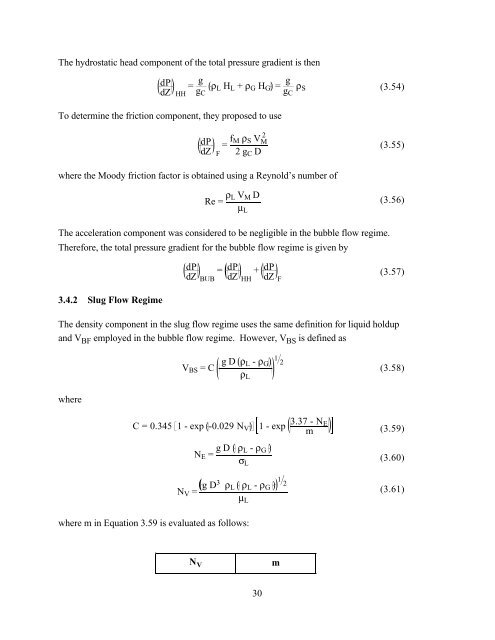multivariate production systems optimization - Stanford University
multivariate production systems optimization - Stanford University
multivariate production systems optimization - Stanford University
Create successful ePaper yourself
Turn your PDF publications into a flip-book with our unique Google optimized e-Paper software.
The hydrostatic head component of the total pressure gradient is then<br />
dP g<br />
=<br />
dZ HH gC ρL HL + ρG HG = g<br />
gC ρS<br />
To determine the friction component, they proposed to use<br />
dP =<br />
dZ F<br />
fM<br />
2<br />
ρS VM 2 gC D<br />
where the Moody friction factor is obtained using a Reynold’s number of<br />
Re = ρL VM D<br />
μL<br />
The acceleration component was considered to be negligible in the bubble flow regime.<br />
Therefore, the total pressure gradient for the bubble flow regime is given by<br />
3.4.2 Slug Flow Regime<br />
dP =<br />
dZ BUB<br />
dP +<br />
dZ HH<br />
dP<br />
dZ F<br />
30<br />
(3.54)<br />
(3.55)<br />
(3.56)<br />
(3.57)<br />
The density component in the slug flow regime uses the same definition for liquid holdup<br />
and V BF employed in the bubble flow regime. However, V BS is defined as<br />
where<br />
VBS = C g D ρL - ρG<br />
ρL<br />
1 2<br />
C = 0.345 1 - exp -0.029 NV 1 - exp<br />
NE = g D ρL - ρG<br />
σL<br />
NV = g D3 ρL ρL - ρG 1 2<br />
μL<br />
where m in Equation 3.59 is evaluated as follows:<br />
N V<br />
m<br />
3.37 - NE<br />
m<br />
(3.58)<br />
(3.59)<br />
(3.60)<br />
(3.61)

















